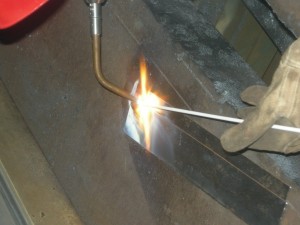|
Braze welding with flux coated rods
The video below is a unique way of using flux that I have never seen before so I thought I would share this video . It's pretty cool if you ask me :). You welders just starting out ,may not know the difference but you welders who have been around for a while know what I mean. ENJOY !!! Braze welding is similar to standard oxyacetylene gas welding except the parent or base metals are not melted, so there is no molten puddle. Instead of a steel alloy filler rod, a flux coated brass filler rod is used. Braze welding is often incorrectly refered to as brazing. Braze welding does not use capillary action to pull filler materialinto the joint-the filler meatal is deposited as fillet or groove welds. The brazing rod is melted by the heat of the metal and the flame, but it should not be held in the flame itself. The parts for braze welding should fit tightly, but the gap is not as important as with brazing. Braze welding is used for joining dissimilar metals and for metals of different thickness. This technique is often used to repair cracked or broken cast iron. Braze welding has less distortion than oxyacetylene welding because less heat is applied to the parts. A disadvantage is that it is not as strong as welding where the base metal is melted, but a well-made braze weld is still sufficient for most non-structural applications. Because the base metals do not need to be melted, braze welding can be done with any of these gases listed below. *Acetylene *Methylacetylene-propadiene *Natural gas *Propane *Propylene NOTE: Make sure the that the equipment - hosesn regulators, torches, and tips are designed for use with the gas you choose .
|





